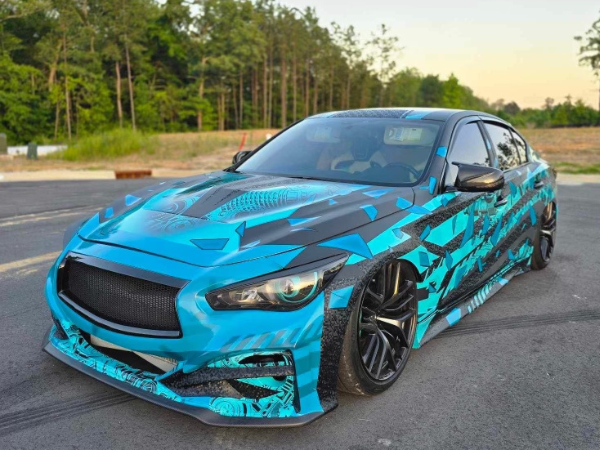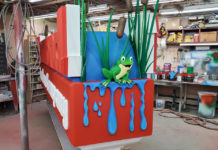Sinner Creations of Spring Lake, North Carolina prides itself on creating elite and impeccable vehicle wraps. Mike and Haley Sinclair, Owners of Sinner Creations, sat down with Sign Builder Illustrated to give us a breakdown of what goes into an award-winning wrap. Read what Mike has to say about the thought process behind a one-of-a-kind, multitextured work of art that placed as a finalist in the 2024 CAMBEA Virtual Wrap Contest.
SBI: Walk us through the original design and the approval process for the second round of the contest.
MIKE SINCLAIR: Going into this competition’s round two was exciting. Once we found out we made it through round one, Haley and I knew we had to find a car that would stand out. At first, we were going to reach out to the community and choose a car that applied for the spot.
After talking more about it, we landed on our car: a fully built out, twin turbo 2018 Infiniti Q50. We chose it for the build criteria and because the owner is someone who has supported us since the beginning. We offered him the sponsorship for the wrap and he accepted.

The design process involved making the client look through the Alltak catalog to find his favorite colors. Once we got his color selections, which had a variety, Haley and I picked four colors to begin with and started to figure out how to mesh all these colors together. After looking on other websites for inspiration, we found a direction we wanted to go in, and saw that four or five colors could work if we had the right designer on our team.
That’s when we called [Daniel Nava] the designer. We told Dan:
- We wanted to print something on the teal and have that same color in the back portion of the car.
2. We wanted the Black Rave texture breaking from the front and layering onto the teal.
3. We wanted abstract lines we could overlay over the teal print.
4. We had to add in Satin Black and brushed black. (When this design was first done, the print was done as skulls.)
After asking the client what he thought, he mentioned that matching the car parts would be super cool. The teal we chose matched perfectly to the brakes and the interior roll cage color. Once we got into the install process and had all the side files cut, we realized we didn’t order enough Black Rave or Black Brushed to complete the front end to match the design template.
We happened to order a deeper blue and decided to change the design up on the fly. We changed to a completely blue bumper with a similar pattern matching the sides ghosted on the film. We also printed the breakage pieces in the same color to continue that fifth color all the way through the car, creating the flow. We figured out how to match the front bumper to the rest of the car by adding scrap of the print and Black Rave we had left. We just let the car’s bodylines help show us what might flow the best.
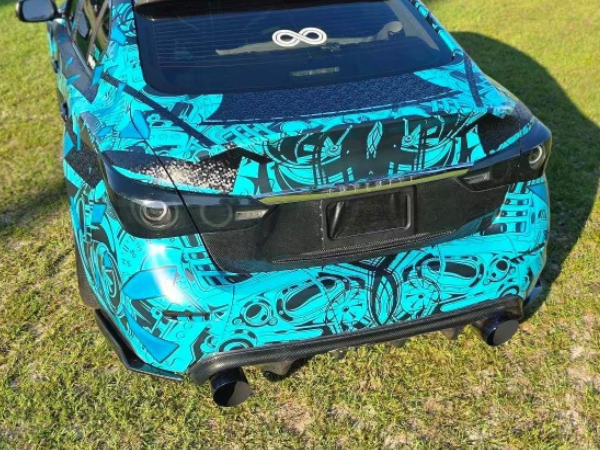
SBI: What type of printer do you use for a job like this?
SINCLAIR: For this project we had our local print shop use their HP Latex 315. After using eco-solvent, latex and UV gel, I have found that the latex has less issues on install. Eco-solvents have trouble lasting and when it comes to UV gel, certain films are extremely fragile and can tear easily. The colors were also all different upon install depending on how far they were stretched. I’ve had several projects printed like this on the HP and the clients are always satisfied with the outcome.
SBI: What was your application process like for this wrap? Did you use any special tools or techniques?
SINCLAIR: Before this competition we had not used Alltak film for an install, but we had used several calendared films before. So we knew what to expect; however, the solvent-based adhesive was different. This adhesive had great air release, but if you heated it after sticking it, and followed that by pulling the excess cut film away, it left adhesive residue on the surface. Just means more cleaning once wrapped over panels.
With the initial tack being a bit higher, we wanted to maintain the arts alignment on the bumpers. So we started with the rear bumper and made some small tears to the backing to get the turbo lined up. We then pulled the backer after tacking the turbo in spot. All the abstract lines are interconnected, cut and weeded.
This was not the easiest, but after getting through the backing release, the install went smoothly. The front bumper was changed at the last minute, which required some creative inlays. Using the colors as layers like the side, matching was the best option.
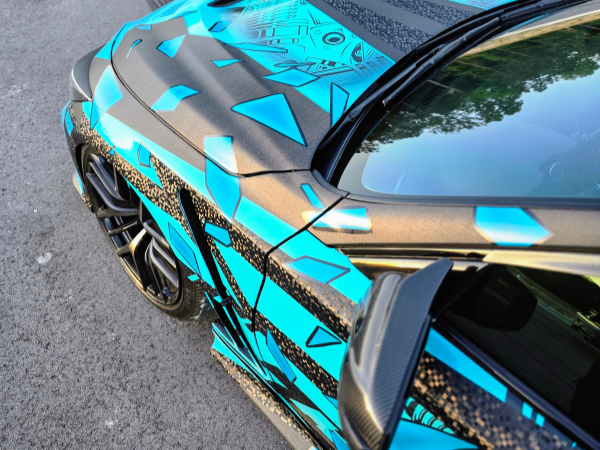
SBI: How long is a wrap like this anticipated to maintain good condition?
SINCLAIR: This being calendar film, expectations are lower, like two to three years. However, if installed improperly it could fail prematurely. Thankfully, we installed this with calendar techniques for longevity.
SBI: What are the methods for preventing sun damage on a wrap that has such a unique color scheme?
SINCLAIR: This wrap was very complex. We had gloss from the teal and blue. We had matte from the print that was printed directly to the teal. There were two different textured films and then the extra satin. From the beginning, we knew printing on the solid color would turn it matte and we knew we couldn’t laminate the ink itself.
We decided ceramic coating was our only option. If unlaminated, the ink would rub away as well. So this was tough during install while cleaning up the adhesive that got left behind. We used our self-healing ceramic coating on this wrap.
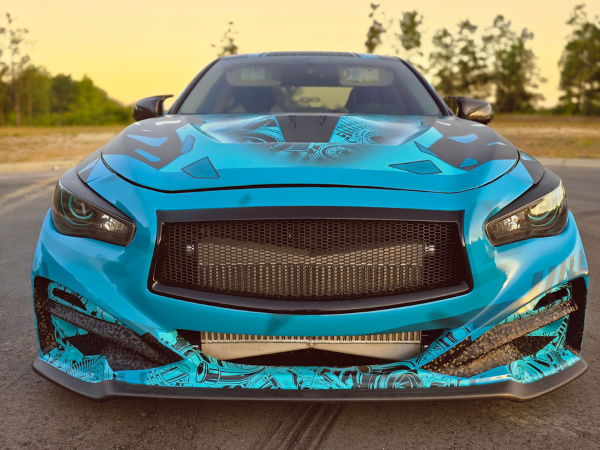
After one month of the car being wrapped, we fixed up any issues that were showing and recoated the car with a second layer. This coating is Resistance by Croftsgate. It’s a five-year coating that will make blacks darker and allow micro scratches made by washing to self-heal under heat. Ceramic is a liquid which is applied, buffed and cured over time and it hardens to fill the pores and make the maintenance of the wrap much easier.


